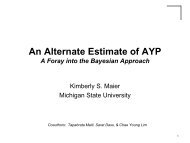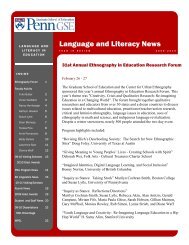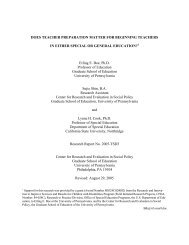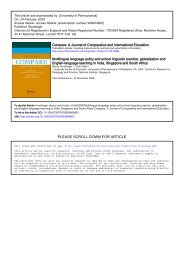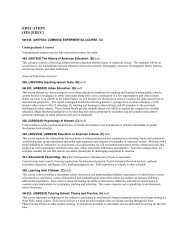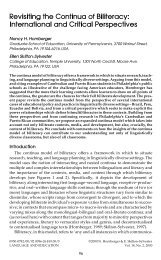Teacher turnover in special and general education: attrition
Teacher turnover in special and general education: attrition
Teacher turnover in special and general education: attrition
You also want an ePaper? Increase the reach of your titles
YUMPU automatically turns print PDFs into web optimized ePapers that Google loves.
<strong>Teacher</strong> Turnover<br />
Discussion<br />
Clearly, teacher <strong>turnover</strong> has been high nationally: 22-23% of public SETs <strong>and</strong> GETs either<br />
left teach<strong>in</strong>g, switched teach<strong>in</strong>g area, or migrated to a different school annually dur<strong>in</strong>g the 1990s.<br />
This level of <strong>turnover</strong> is even higher than reported elsewhere (e.g., Ingersoll, 2003) because we<br />
<strong>in</strong>cluded teach<strong>in</strong>g area transfer as part of <strong>turnover</strong> as well as <strong>attrition</strong> <strong>and</strong> migration. Not only is<br />
the rate of overall teacher <strong>turnover</strong> high, but it actually <strong>in</strong>creased by over a third dur<strong>in</strong>g the n<strong>in</strong>e<br />
years from 1991-92 to 2000-01 due to growth <strong>in</strong> the rates of <strong>attrition</strong> <strong>and</strong> teach<strong>in</strong>g area transfer.<br />
The field of <strong>education</strong> has allowed this to happen even though it has been recognized that teacher<br />
<strong>turnover</strong> is costly <strong>in</strong> terms of student achievement, school function<strong>in</strong>g, <strong>and</strong> f<strong>in</strong>ancial expenditures<br />
(see review by Johnson et al., 2005). Of course, the impact of teacher <strong>turnover</strong> must be, has been,<br />
<strong>and</strong> no doubt will be managed every year by our public school systems. Its costs will cont<strong>in</strong>ue to<br />
be paid, however, unless better ways to reduce these costs are devised <strong>and</strong> implemented to scale.<br />
We recognize that some <strong>in</strong>itiatives to reduce the high <strong>and</strong> <strong>in</strong>creas<strong>in</strong>g rates of teacher<br />
<strong>turnover</strong> have been effective at the state <strong>and</strong> local levels. However, the cumulative effects of<br />
these <strong>in</strong>itiatives have not been sufficient to halt the steady growth of <strong>turnover</strong> at the overall<br />
national level. The <strong>turnover</strong> of teachers <strong>in</strong> public schools has been costly to the field <strong>and</strong> a<br />
significant contributor to the shortage of sufficient numbers of qualified teachers <strong>in</strong> both <strong>special</strong><br />
<strong>and</strong> <strong>general</strong> <strong>education</strong>. There are three ma<strong>in</strong> approaches to deal<strong>in</strong>g with these problems: (a)<br />
<strong>in</strong>itiate renewed efforts to reduce each of the three types of <strong>turnover</strong>, (b) improve the<br />
management of the costs of teacher <strong>turnover</strong>, <strong>and</strong> (c) <strong>in</strong>crease the supply of qualified teachers.<br />
These approaches will be discussed <strong>in</strong> turn.<br />
Attrition<br />
Our analyses of teacher <strong>attrition</strong> are relevant to the issues of whether teacher shortages are<br />
mostly due to excessive <strong>attrition</strong> or to <strong>in</strong>adequate supply, <strong>and</strong> whether the most promis<strong>in</strong>g<br />
response to teacher shortages is exp<strong>and</strong>ed efforts to <strong>in</strong>crease the retention of employed teachers<br />
or, <strong>in</strong>stead, to <strong>in</strong>crease the supply of qualified teachers. Accord<strong>in</strong>g to Ingersoll (2001) <strong>and</strong><br />
NCTAF (2003), excessive <strong>attrition</strong> (therefore <strong>in</strong>adequate retention) is the crux of the teacher<br />
shortage problem because excessive <strong>attrition</strong> creates high dem<strong>and</strong> for hir<strong>in</strong>g enter<strong>in</strong>g teachers. In<br />
this view, teacher supply would be sufficient (except <strong>in</strong> several subjects) if it were not for such<br />
high dem<strong>and</strong> due to <strong>attrition</strong>.<br />
30



